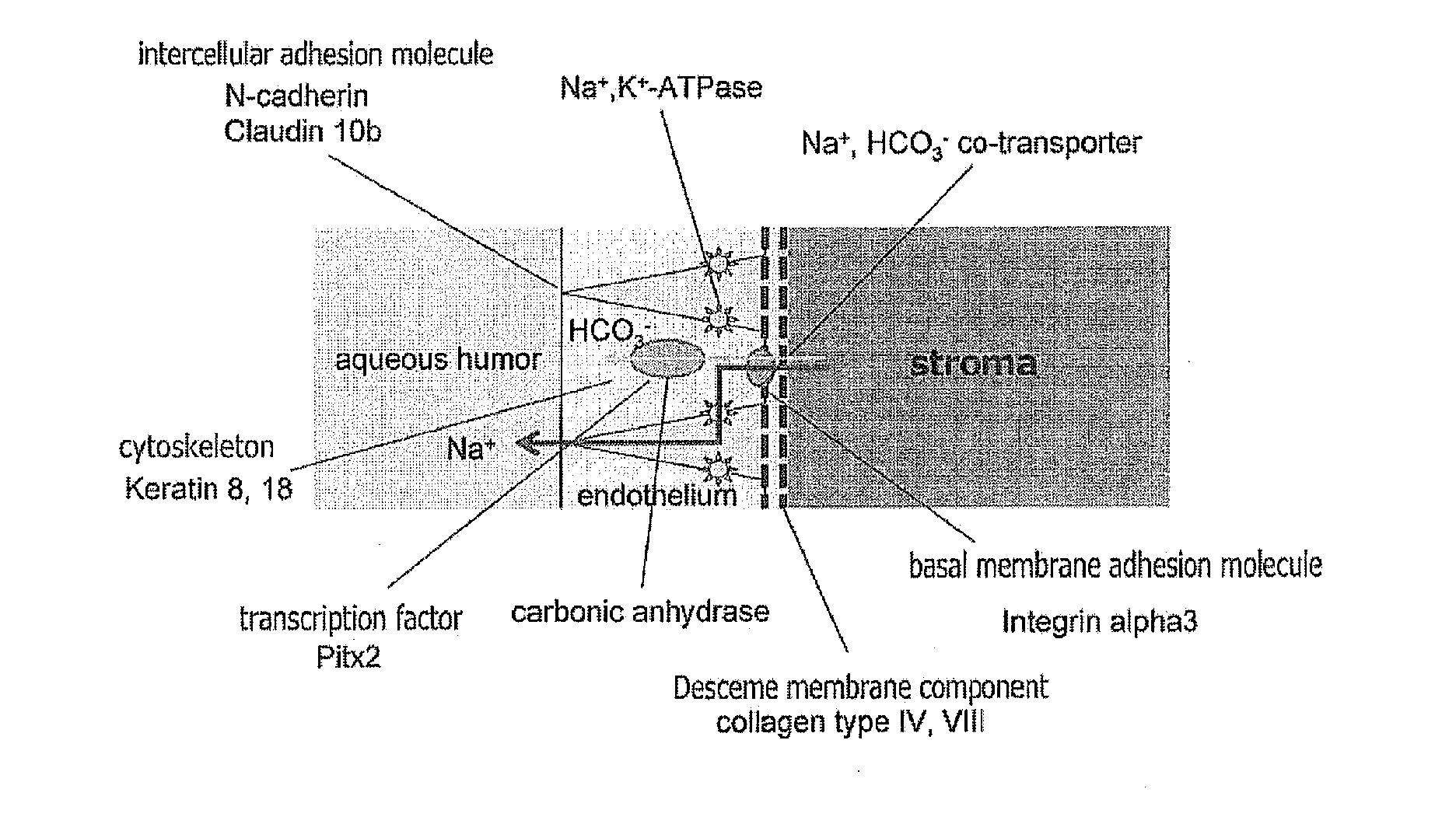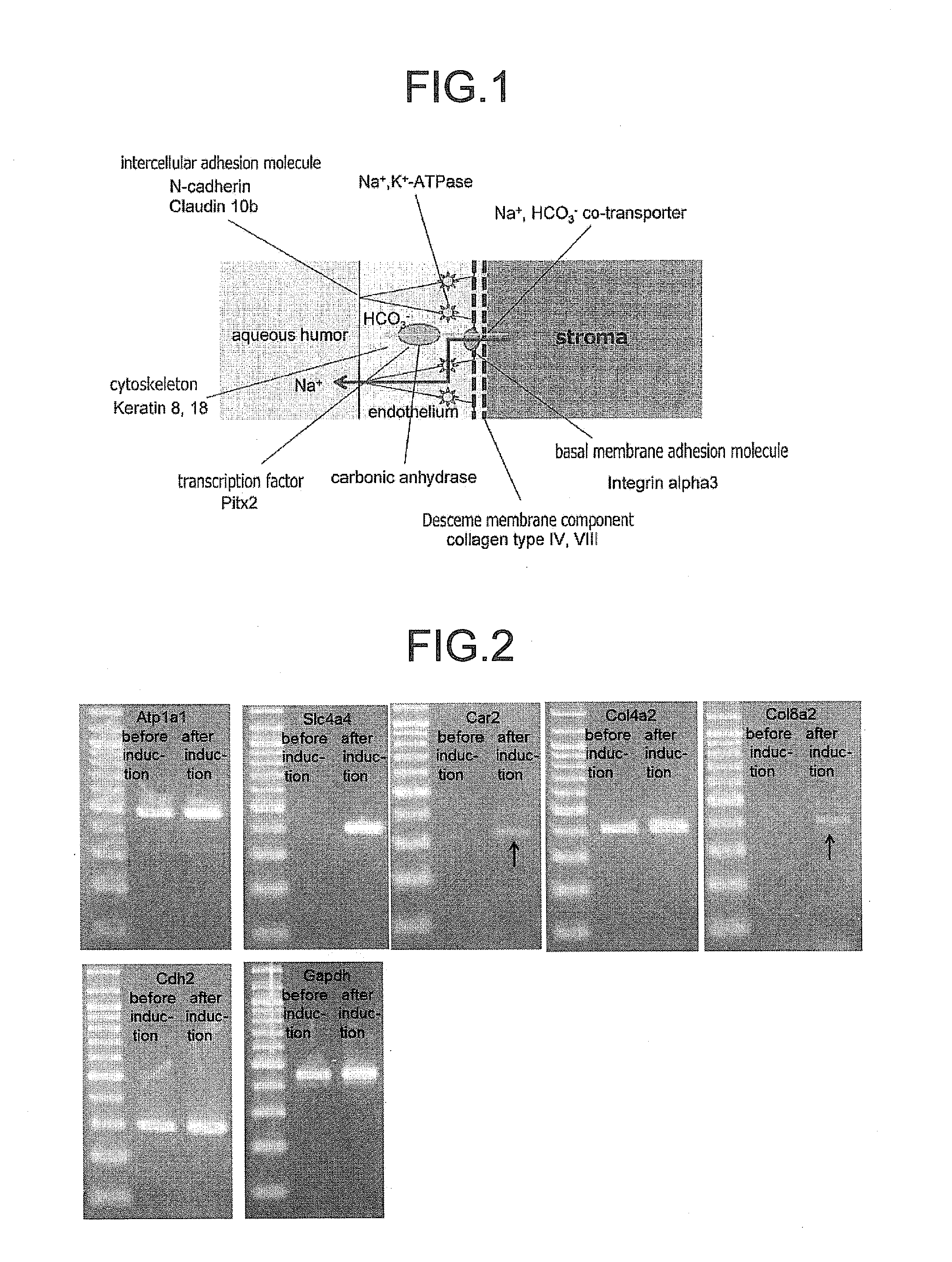Method for producing corneal endothelial cell
a stem cell and corneal technology, applied in the field of stem cell production of corneal endothelial cells, can solve the problems of corneal stroma edema, reduced corneal transparency, and serious influence on visual function, and achieve the effect of producing more efficiently
- Summary
- Abstract
- Description
- Claims
- Application Information
AI Technical Summary
Benefits of technology
Problems solved by technology
Method used
Image
Examples
example 1
Differentiation Induction of Mouse COPs into Corneal Endothelial Cells
(Material and Method)
1. Separation of Mouse COPs
[0077]Mouse COPs were separated from mouse cornea according to a publication (non-patent document 4). The corneal stromal disc was cut out from mouse (C57BL / 6 mouse), processed into small pieces and digested with 0.05% trypsin (Sigma-Aldrich, St. Louis, Mo.) at 37° C. for 30 min. Then, they were treated with 78 U / ml collagenase (Sigma-Aldrich) and 38 U / ml hyaluronidase (Sigma-Aldrich) at 37° C. for 30 min. Parenchymal cells were mechanically dissociated to give single cells, and cultured in DMEM / F-12 (1:1) medium containing 20 ng / ml EGF (Sigma-Aldrich), ng / ml FGF2 (Sigma-Aldrich), B27 supplement (Invitrogen, Carlsbad, Calif.), and 103 U / ml LIF (Chemicon International, Temecula). The cells were cultured at plating density of 1×105 cells / ml under humidified atmosphere containing 5% CO2 at 37° C. The first culture was performed in a 35 mm dish, and thereafter in a 25 cm...
example 2
Differentiation Induction of Human iPS Cell-Derived Neural Crest Stem Cell into Corneal Endothelial Cell—(1)
(Material and Method)
1. Preparation of Human iPS Cell-Derived Neural Crest Stem Cell
[0080]Based on a publication (Nature Protocols, 2010 vol. 5, No. 4, 688-701), neural crest stem cells were obtained from human iPS cell. This Example is different from the above-mentioned publication in that floating culture was employed without using Matrigel for culturing iPS cells. Suspension culture enabled more efficient induction of differentiation into neural crest stem cells. The human iPS cells used were 201B7 (provided by Prof. Shinya Yamanaka (Kyoto University) and Prof. Hideyuki Okano (Keio University)).
2. Preparation of Differentiation Induction Medium
[0081]The medium was prepared in the same manner as the differentiation induction medium used in Example 1.
(Results)
[0082]Human iPS cell-derived neural crest stem cells were plated in a gelatin-coated 35 mm dish (Asahi Techno Glass) a...
example 3
Evaluation of Corneal Endothelial Cell (Corneal Endothelial Cell Marker Measurement)
[0083]Using corneal endothelial cells obtained by inducing differentiation of COPs, which were prepared in the same manner as in Example 1, and corneal endothelial cells obtained by inducing differentiation of human iPS cell-derived neural crest stem cells, which were obtained in the same manner as in Example 2, the expression state of corneal endothelial cell marker was examined by RT-PCR method. The primers used are shown in Table 1 (for mouse) and Table 2 (for human).
TABLE 1for mouse COPsprod-Forward sequenceReverse sequenceuctGene(5′-3′)(3′-5′)sizeAtp1a1CCATCGCTTACACCCTATCTTGCAGATGACCAAG492ACC (SEQ ID NO: 1)TCG (SEQ ID NO: 2)Slc4a4TCTTCCTGGGCACTTACAGGAGCATACCACCATG408ACC (SEQ ID NO: 3)AGG (SEQ ID NO: 4)Car2GATCCTTGCTCCCTTCTATCACCCAGCCTAACTG326TCC (SEQ ID NO: 5)TGC (SEQ ID NO: 6)Col4a2TGGAGTTCCTGGTTTGATCACCAAAGTCCCCAGT420AGG (SEQ ID NO: 7)AGG (SEQ ID NO: 8)Col8a2GGTCCAGTAGGGGCTAACCTGTAAAACCTGGCTC4...
PUM
| Property | Measurement | Unit |
|---|---|---|
| concentration | aaaaa | aaaaa |
| concentration | aaaaa | aaaaa |
| temperature | aaaaa | aaaaa |
Abstract
Description
Claims
Application Information
 Login to View More
Login to View More - R&D
- Intellectual Property
- Life Sciences
- Materials
- Tech Scout
- Unparalleled Data Quality
- Higher Quality Content
- 60% Fewer Hallucinations
Browse by: Latest US Patents, China's latest patents, Technical Efficacy Thesaurus, Application Domain, Technology Topic, Popular Technical Reports.
© 2025 PatSnap. All rights reserved.Legal|Privacy policy|Modern Slavery Act Transparency Statement|Sitemap|About US| Contact US: help@patsnap.com



